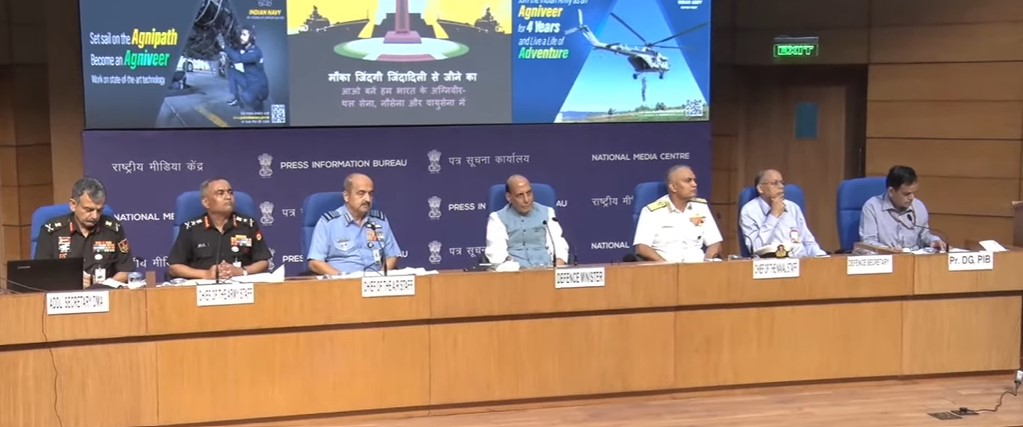Editor’s Note
Agnipath – Tour of Duty (TOD) – has been announced by the Government. The services will enroll personnel for four years and retain only 25 per cent of such recruits for full service thereafter. The new policy would have a profound effect on the services. It will lower the mean age of the combatant, as we simultaneously witness a downward slant of the pension expenditure graph.
..……………………………………………………………………………………………………………………………….
Warfighting is undergoing major changes the world over with enhanced usage of technological prowess, cyber warfare, and social media tools being some of the drivers. Along with countries preparing themselves for such changes based on their threat perception, the Russia-Ukraine war is throwing up new lessons every day. While countries are grappling with these challenges, financial considerations are also becoming an important aspect of the restructuring of the armed forces. On one hand, cheaper options in the form of drones, swarm drones etc., are being preferred instead of costly weapon systems, on the other, there is a renewed focus on rightsizing of the defence forces including reduction of strength where feasible to get the funds for the modernisation of the armed forces. This trend is visible the world over, including in India.
In addition, India is at the cusp of becoming a regional power on its way to a greater global role in the coming decade. It is therefore essential that it undertakes major reforms in its defence forces to make them future-ready which necessitates the need of maintaining a younger age profile in the armed forces and training these personnel to lead troops at the small team level, operate more advanced weapons and understand the nuances of modern war fighting better. At the national level, it is essential that we have disciplined, skilled and motivated youth to propel the nation toward its intended growth trajectory. The TOD scheme enhances qualitative content in our armed forces to make it future-ready and enhances the character qualities of the youth of the country.
Certain major aspects of the scheme are as under:
- The scheme will draw entrants from All India All Class composition (AIAC)
- The initial period of service will be for four years after which they may be released. 25 per cent of these personnel will be retained, based on assessment, who will in turn serve as per the terms and conditions of the present-day serving soldier
- Separate terms and conditions have been brought in with respect to TOD soldiers for their pay, risk allowance and severance package
- While the severance package will be generally in the range of 10 lakhs, the envisaged scheme calls for 30 per cent of pay being contributed by the Agniveer, while the government contributes a similar amount. Death and disability benefit while in service will be substantial. All the allowances applicable to a particular place of posting will also be available to the TOD recruits.
- Entry age has been kept at 17 ½ to 21 years. It facilitates those soldiers who are not retained to yet be in the age bracket to apply for CAPF, state police services and all other Government jobs.
- Some skill sets in the form of ITI training and/or enhanced educational qualifications will be catered for enabling them to get better employment post-release.
There was widespread criticism from the veterans regarding TOD, before its announcement. While the criticism has already made its contribution leading to the refinement of the scheme before its rollout, it is imperative that at this stage we look at the positives of the scheme regarding our country in general and the Armed Forces in particular. Due to the peculiarities of the scheme some of the major aspects are discussed below:
All India All Class (AIAC) Composition
The TOD soldiers or Agniveers, will be recruited from AIAC composition which is a crying need of modern-day India. Some important aspects are as under:
Class based recruitment is of World War era legacy, which requires to be changed for India 2022 and beyond.
- There are no inputs to suggest that AIAC troops will perform any lesser than the fixed class composition. Brigade of the Guards raised post-Independence on AIAC basis is a shining example of the same. Some of the Mahar battalions, JAT battalions and expanded base of majority of units including Gorkha Regiments indicate the wide-ranging acceptance of this recruitment system. Close to 85 per cent of the Armed Forces are already based on the AIAC model and that must reach a 100 per cent to have inclusive approach for the entire youth of the country.
- The current class-based approach has benefitted only a few states whereas other states have lagged despite having recruitable youth of equal or even greater calibre. The Agnipath scheme will correct this anomaly at the national level.
- Even though Rashtriya Rifles units are an amalgamation of personnel of various arms as well as tenure-based employment, still they are excelling not only in CI/CT areas but are capable of filling up operational voids too.
- Army has already stated through an affidavit in Supreme Court way back in 2013 that Army does not discriminate based on religion, race, caste, sex, descent, place of birth, residence or any other grounds.
- Induction of women initially in the Officers Cadre and now as soldiers in the Tour of Duty model will be part of our cherished dream of equality in the country.
Qualitative Surge in the Armed Forces
Despite the large number of applicants for recruitment, those recruited may not apply themselves wholeheartedly to the profession since they have an assured job. With only 25 per cent retention, the recruits will apply themselves more diligently to be a part of the 25 per cent to be retained. The quality of our soldiers and unit performance will increase. Over a period, the unit’s combat effectiveness will be upgraded. This new lot will be able to handle technical equipment better, lead small team actions and will contribute to a future-ready Army. The TOD concept will therefore change the entire fabric of the unit, positively.
Prospects of the Released 75 per cent
Often an issue is raised as to what will happen to the 75 per cent who are released after their initial four years of service. The following aspects are important in this regard:
- These people will be in the age bracket to apply for CAPF and State Police Forces besides all government jobs. Due to their training and being with the Armed Forces, majority will be selected on their own merit
- Due to skill sets developed while serving, which includes ITI training or other skill development mechanisms at the national level, they will get jobs in the corporate sector as a preferred lot which will be beyond guard duties
- Educational qualifications being planned to be given to them during their service period will enable them to get better jobs outside
- A severance package of more than 10 lakhs will empower them financially and help them in taking off as entrepreneurs if an enabling environment is provided
- Those who sacrifice their lives or suffer a disability will be appropriately compensated.
No scheme is perfect, and they all have their pros and cons. There is an urgent need to roll out this important scheme and look at the positive spin-offs. We will have adequate time and opportunity to course-correct if there is a necessity. Even if 40,000 vacancies are released per year in this category, it will be just 4 per cent of our Armed Forces, hence, there is no harm in giving it a try. It will also address some of the revenue expenditure concerns related to paying and pensions. As far as the strength of the Armed Forces is concerned, it should be strict as per our operational needs aligned to future wars which have to be fought with China and Pakistan fielding their strengths together, given the current threat perception.
Maj Gen Ashok Kumar (Retd)






















